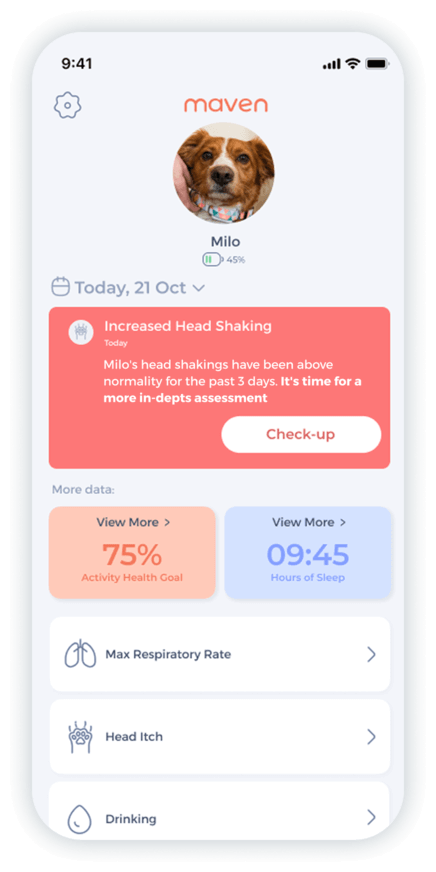Why Is My Dog Puking Yellow? What the Color Means (Vet Verified)
Few things are as alarming for a pet parent as waking up to the sound of their furry friend vomiting. And when that vomit is yellow, it immediately raises questions: “Why is my dog puking yellow?” Is it serious?
Yellow vomit in dogs is a common occurrence and usually indicates the presence of bile, a digestive fluid. It’s often a harmless sign of an empty stomach, but it can sometimes point to a more significant health issue.
In this article, we’ll explain exactly why your dog might be throwing up yellow bile or foam, what different consistencies mean and how the Maven Pet Health Tracker can help you monitor these episodes and other vital signs.
Key Takeaways
- Yellow Vomit = Bile: Seeing yellow vomit almost always means your dog is bringing up bile from an empty stomach.
- Foam Indicates Stomach Acid/Air: If the yellow vomit is foamy, it typically means there’s more stomach acid and/or air mixed in.
- Consistency Matters: Yellow liquid suggests mostly bile. Yellow foam indicates more gastric contents, air, or irritation.
- When to Worry: Contact your vet immediately if vomiting is frequent, continuous, projectile, or accompanied by lethargy, appetite loss, diarrhea, abdominal pain, or other concerning symptoms.
- Track with Maven: The Maven Pet Monitor can help you track vomiting episodes and associated behavioral changes, providing valuable data for your vet.
Why Is My Dog Puking Yellow?

When a dog vomits yellow, it’s almost always due to the presence of bile.
Bile is a yellowish-green fluid that helps with digestion, particularly the breakdown of fats in the small intestine.
The most frequent reason for a dog to vomit yellow bile is an empty stomach. When your dog’s stomach is empty for too long, bile can irritate the stomach lining, leading to nausea and subsequent vomiting.
Why Is My Dog Puking Yellow Foam?
If your dog is puking yellow foam, it generally means that along with bile, there’s a significant amount of stomach acid and air mixed in.
The “foam” is created when the stomach acid and bile churn together with swallowed air as the dog gags and heaves.
This can still be a symptom of an empty stomach, as an irritated, empty stomach often produces excess acid.
However, it can also be associated with conditions that cause more intense gastric upset or prolonged nausea.
“I got the Maven sensor for my 14-year-old Chihuahua mix with heart and trachea issues. It gave me back peace of mind – I can track her RRR, BPM, drinking, and activity anytime and know instantly if something’s wrong. Highly recommend!”

★★★★★
Chiara De Luca
Titti
Why Is My Dog Throwing Up Yellow Foam?
The foamy consistency, as mentioned, is due to the presence of stomach acid and air alongside the yellow bile.
This can happen particularly if your dog has been dry heaving for a while before actually expelling anything.
Why Is My Dog Puking Yellow Liquid?
When your dog is puking yellow liquid, it typically indicates a higher proportion of bile and stomach fluids compared to foamy vomit.
This can often be seen in cases of bile reflux vomiting where the stomach is primarily empty, and the expelled contents are mostly bile without much solid food or excessive air.
It’s essentially just the digestive juices being brought up.
Why Is My Dog Puking Up Yellow Bile?
Bile is the key component that gives the vomit its yellow color. Usually, an empty stomach is the cause behind bile reflux, but sometimes it signals more serious gastrointestinal problems where bile is irritating the stomach or being forced back up.
Common Causes of Yellow Vomit

Let’s look at a few other conditions that can cause a dog to vomit yellow bile or foam besides an empty stomach:
- Dietary Indiscretion: Eating something they shouldn’t have can upset the stomach and cause vomiting, even after the food is digested and only bile remains.
- Food Sensitivity: A sudden change in diet or an intolerance to certain food ingredients can lead to an upset stomach and yellow vomiting.
- Gastrointestinal Issues: Conditions like gastritis (inflammation of the stomach lining), inflammatory bowel disease, or ulcers can cause chronic irritation and vomiting.
- Pancreatitis: Inflammation of the pancreas often causes severe vomiting (which can include bile), abdominal pain, and lethargy.
- Liver Disease: The liver produces bile, so problems with liver function can affect bile production and flow, potentially leading to vomiting.
- Intestinal Obstruction: While usually accompanied by other symptoms like severe pain and lack of stool, a blockage can cause repeated vomiting.
- Medication Side Effects: Some medications can cause nausea and vomiting as a side effect.
- Motion Sickness: Traveling in a car can cause some dogs to experience nausea and vomit bile.
When to Worry and See a Vet
“Yellow vomit usually means your dog is bringing up bile. While it can be harmless, frequent vomiting or changes in appetite, energy, or stool always deserve a vet check. Never hesitate to call your vet if you’re concerned.” Joana Babo, DVM, Veterinarian at Maven Pet
Call your vet immediately if your dog is puking yellow and exhibits any of these signs:
- Frequent or Continuous Vomiting
- Projectile Vomiting
- Vomiting for More Than 24 Hours
- Lethargy or Weakness
- Loss of Appetite
- Diarrhea (especially bloody diarrhea)
- Abdominal Pain
- Dehydration
- Changes in Drinking
- Attempts to Vomit Without Success
How the Maven Pet Health Monitor Helps Track Digestive and Behavioral Changes
When your dog vomits, it’s important to observe not just the vomit itself, but also associated changes in their behavior and well-being.
The Maven Pet Health Monitor can help you identify these changes in real time.


Monitor heart rate, respiratory rate, activity & rest, drinking, itch behavior.
This device tracks key behavioral metrics 24/7, providing objective data that can help you and your vet understand the full picture:
- Vomiting Frequency: Record each episode directly in the pet health app, giving your vet a precise timeline.
- Appetite Changes: The monitor can indirectly indicate appetite loss by showing reduced activity around meal times or prolonged periods of inactivity after meals.
- Lethargy and Rest Patterns: A significant increase in resting time or a decrease in activity levels often accompanies nausea or illness, providing an early warning.
- Changes in Hydration: While not directly measured, severe thirst or reluctance to move to the water bowl can be observed through activity patterns.
Takeaways Recap
- Yellow Vomit is Bile: Primarily signifies that your dog is expelling bile, most often due to an empty stomach or minor gastric irritation.
- Observe Consistency: Foamy vomit usually includes more air and stomach acid, while liquid vomit is primarily bile.
- Not Always Harmless: Persistent or severe yellow vomiting, especially with other symptoms like lethargy or loss of appetite, warrants immediate vet consultation.
- Track Symptoms Proactively: Use a dog health tracker like the Maven’s device to log vomiting episodes and monitor changes in your dog’s activity and behavior, providing crucial data for your vet.
Maven Pet focuses on improving the quality of life of our pets with technology, using artificial intelligence (AI) to enable proactive pet care. By accurately collecting and monitoring pet data 24/7 and flagging any irregularities, Maven Pet empowers pet parents and veterinarians to stay ahead of potential health issues, ensuring the well-being and longevity of our beloved companions.




